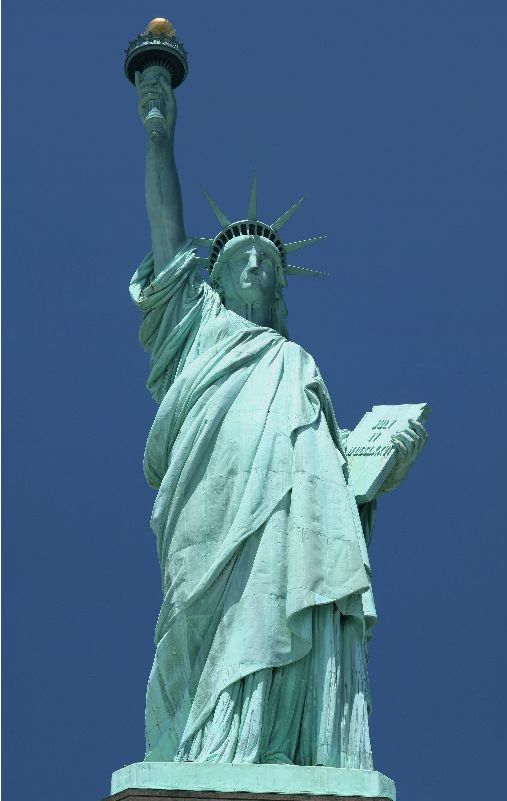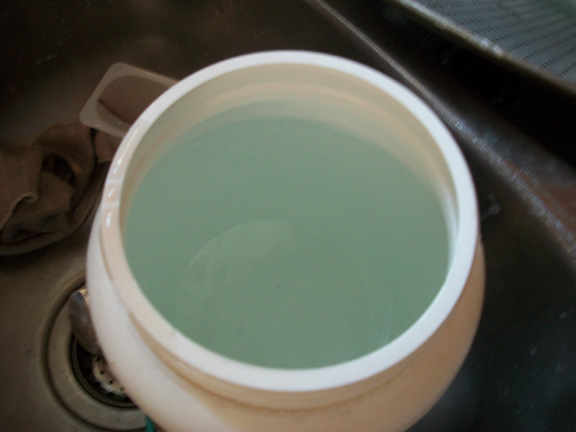Patina is a beautiful, green mixture of products derived from copper at the mercy of oxidation, various forms of pollution and thermodynamics. It not only coats the Statue of Liberty but is found on bronze statues, copper roofs and old copper dishes, hence the name patina, Latin for dish.
If you take powdered copper and heat it in a crucible, the combination of increased surface area and higher average kinetic energy augment the likelihood of successful encounters between copper and oxygen. What forms is CuO, named copper(II) oxide, once known as cupric oxide. Under natural and milder conditions, Cu2O forms. Although some sheltered bits persist as such, for most atoms it is not copper’s ultimate fate. In Cu2O, copper’s oxidation state is only +1. When further oxidation occurs thanks to moisture and oxygen, each Cu+ loses another electron to become Cu2+. The ions eventually bind to hydroxide(OH–) and to sulfate(SO42-), a sulfur dioxide (SO2) derivative. Hydroxide ion is a product of oxidation which also makes its appearance in the corrosion of steel. Sulfur dioxide, is an emission of volcanoes, smelters and coal power plants. The compound made is posnjakite, Cu4(SO4)(OH)6 · 2H2O , but it eventually turns into the same compound found in a greenish mineral named brochantite.
Brochantite, Cu4(OH)6SO4, more accurately represented as CuSO4.3Cu(OH)2, is usually patina’s main compound, but from naked eye observations alone, it’s obvious that patina cannot be only brochantite. For one thing, unlike Lady Liberty’s veneer, the mineral is either translucent or transparent, and the latter would not cling to her.
 Prior to research done during the years of the Great Depression, it was believed that a different mineral , basic copper carbonate— malachite (CaCO3.Cu(OH)2) was patina’s major constituent. The chemists’ investigation revealed that regardless of the patina’s source, it was only a minor component which nevertheless contributed to patina’s opaque nature. Interestingly, if the patina’s origin was rural, it would makeup a bit less than 3% of the whole; if from London, the percent of the carbonate mineral would be as high as 24. The higher concentrations of carbon dioxide in the urban setting were responsible for this as copper ions soaked up CO2, combining with ionic products of the gas. If it were not for the prohibitively expensive cost of copper roofs, replacing typical bituminous (so-called asphalt) roof shingles with copper ones would be an attractive green alternative, in more ways than one.
Prior to research done during the years of the Great Depression, it was believed that a different mineral , basic copper carbonate— malachite (CaCO3.Cu(OH)2) was patina’s major constituent. The chemists’ investigation revealed that regardless of the patina’s source, it was only a minor component which nevertheless contributed to patina’s opaque nature. Interestingly, if the patina’s origin was rural, it would makeup a bit less than 3% of the whole; if from London, the percent of the carbonate mineral would be as high as 24. The higher concentrations of carbon dioxide in the urban setting were responsible for this as copper ions soaked up CO2, combining with ionic products of the gas. If it were not for the prohibitively expensive cost of copper roofs, replacing typical bituminous (so-called asphalt) roof shingles with copper ones would be an attractive green alternative, in more ways than one.

Patina on outdoor plumbing in Montreal. Copper’s proximity to the sea and its source of chloride will influence the percentage of a third green mineral constituent, atacamite (CuCl2.3Cu(OH)2).
During the Statue of Liberty’s restoration 25 years ago, Bell Research labs applied some more sophisticated techniques than were available during the depression years to analyze patina. They found that in some samples, atacamite was even more prevalent than brochantite. (I wonder if patina from cold inland cities exposed to lots of winter street salt also show elevated levels of atacamite.) When they heated patinas, mass spectrographical analysis of the resulting gases not only confirmed the presence of carbonates from the decomposition of malachite but also oxalates, another indication of patina’s complexity.
But what makes the minerals cling to the copper underneath the patina? To investigate this, the Bell researchers used acetone, the main constituent of nail polish remover. This solvent will not dissolve patina’s minerals but will extract various hydrocarbons which were revealed by mass spec to be monocarboxylic acids, alkanes, and polynuclear aromatic compounds. If old patina is removed and placed on a fresh sheet of copper, within a week organic pollutants will bind it to the unoxidized metal. According to another Bell study, old patina’s “organic glue” is strong enough to make it resistant to most acidic precipitation, with the possible exception of acidic fog. Do not, however, imagine that the patina is completely insoluble. A copper roof’s patina loses between 1.0 and 1.5 g/m2 of copper per year according to a 2002 Swedish study.
The strength of the bond between patina and metal is up to point proportional to the time the patina is exposed to the atmosphere. There are many recipes that can be used to quickly form patina, but the lab versions tend to flake off. Powder X ray diffraction techniques also reveal that synthetic patinas have smaller crystals since they formed more quickly. These characteristics help investigators identify forged artifacts which are given a fake coating to make them look old. The uninitiated often do not realize that even in a non living colored mixture, there is far more than meets the eye.
Postscript
Years ago I tried to make artificial #patina, the stuff that covers old bronze statues. ‘Found the sample. Turns out to be just a hydrate of copper citrate.

Evidence? When I BBQ’d it, it went from patina-green to blue as H₂O from crystalline structure was driven off.

References
R.L. Opilaa AT&T Bell Laboratories. Copper patinas: an investigation by Auger electron spectroscopy Corrosion Science.
Volume 27, Issue 7, 1987, Pages 685-694
K Nassaua, A.E Millera and T.E Graedela AT&T Bell Laboratories. The reaction of simulated rain with copper, copper patina, and some copper compounds. Corrosion Science
Volume 27, Issue 7, 1987, Pages 703-719
Amy J. Mullera and Carolyn McCrory-Joy AT&T Bell Laboratories. Chromatographic Analysis of copper patinas formed in the atmosphere. Corrosion Science
Volume 27, Issue 7, 1987, Pages 695-701
K. Nassaua, P.K. Gallaghera, A.E. Millera and T.E. Graedela
The characterization of patina components by X-ray diffraction and evolved gas analysis. Corrosion Science. Volume 27, Issue 7, 1987, Pages 669-684
B. De Filippo et al. Characterization of Bronze Corrosion Products on Exposition to Sulphur Dioxide. Advanced Materials Research (Volume 138) 2010
1929 – Vernon and Whitby. “The Open-Air Corrosion of Copper. A Chemical Study of the Surface Patina”. J. Inst. Metals, 24, no. 2, 1929, pp. 181-95.
Ivars Peterson “Lessons learned from a lady; the recent Statue of Liberty restoration provided some unique research opportunities“. Science News.
http://findarticles.com/p/articles/mi_m1200/is_v130/ai_4610599/
Paul Craddock. Scientific investigation of copies, fakes and forgeries. Butterworth-Heinemann. 2009
C. Karlén, I. Odnevall Wallinder D. Heijerickand C. Leygraf. Runoff rates, chemical speciation and bioavailability of copper released from naturally patinated copper. Environmental Pollution Volume 120, Issue 3, December 2002, Pages 691-700



 One can argue that the tap water I used is not pure. Admittedly, various ions, algae and even suspended silt and mud can definitely introduce all sorts of green and brown hues. If you fill a mixing bowl with deionized water from the lab, which is created by forcing water through an impurity-removing column, the water is still colored.
One can argue that the tap water I used is not pure. Admittedly, various ions, algae and even suspended silt and mud can definitely introduce all sorts of green and brown hues. If you fill a mixing bowl with deionized water from the lab, which is created by forcing water through an impurity-removing column, the water is still colored.
 If you have the artist’s color wheel in mind, you may be confused by the absorption of red leading to the transmission of blue. Although red’s opposite is green, red’s wide range of wavelengths is actually complementary to all hues of green, cyanide and blue. I’ve drawn a color wheel which is proportional to perceived wavelengths to illustrate this point.
If you have the artist’s color wheel in mind, you may be confused by the absorption of red leading to the transmission of blue. Although red’s opposite is green, red’s wide range of wavelengths is actually complementary to all hues of green, cyanide and blue. I’ve drawn a color wheel which is proportional to perceived wavelengths to illustrate this point. In the 1950’s, Knut Schmidt-Nielsen and his wife injected a harmless dye in to a camel’s bloodstream. They waited a while for the dye to distribute itself evenly. Then they took a blood sample and measured the concentration of the dye. Then the camel went 8 days without drinking in the desert heat. Although it lost a lot of weight (over 40 litres of water), the concentration of the dye in the blood revealed that the blood had only lost about 1 litre of water. In other words the rest of the water had been lost from tissues.
In the 1950’s, Knut Schmidt-Nielsen and his wife injected a harmless dye in to a camel’s bloodstream. They waited a while for the dye to distribute itself evenly. Then they took a blood sample and measured the concentration of the dye. Then the camel went 8 days without drinking in the desert heat. Although it lost a lot of weight (over 40 litres of water), the concentration of the dye in the blood revealed that the blood had only lost about 1 litre of water. In other words the rest of the water had been lost from tissues.